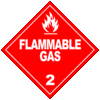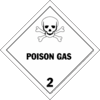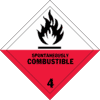IMDG Codes and Symbols
CLASSIFICATION OF DANGEROUS GOODS
The International Maritime Dangerous Goods (IMDG) Code was developed as a uniform international code for the transport of dangerous goods by sea covering such matters as packing, container traffic and stowage, with particular reference to the segregation of incompatible substances.
The Carriage of dangerous goods and marine pollutants in sea-going ships is respectively regulated in the International Convention for the Safety of the Life at Sea (SOLAS) and the International Convention for the Prevention of pollution from Ships (MARPOL).
Relevant parts of both SOLAS and MARPOL have been worked out in great detail and are included in the International Maritime Dangerous Goods (IMDG) Code, thus making this Code the legal instrument for maritime transport of dangerous goods and marine pollutants. As of 1st January 2004, the IMDG Code has become a mandatory requirement.
For all modes of transport (sea, air, rail, road and inland waterways) the classification (grouping) of dangerous goods, by type of risk involved, has been drawn up by the UNITED NATIONS Committee of Experts on the Transport of Dangerous Goods (UN).
Class 1: Explosives

Subclass 1.1: Explosives with a mass explosion hazard
Consists of explosives that have a mass explosion hazard. A mass explosion is one which affects almost the entire load instantaneously.
Subclass 1.2: Explosives with a severe projection hazard
Consists of explosives that have a projection hazard but not a mass explosion hazard.
Subclass 1.3: Explosives with a fire
Consists of explosives that have a fire hazard and either a minor blast hazard or a minor projection hazard or both but not a mass explosion hazard.
Subclass 1.4: Minor fire or projection hazard
Consists of explosives that present a minor explosion hazard. The explosive effects are largely confined to the package and no projection of fragments of appreciable size or range is to be expected. An external fire must not cause virtually instantaneous explosion of almost the entire contents of the package.
Subclass 1.5: An insensitive substance with a mass explosion hazard
Consists of very insensitive explosives with a mass explosion hazard (explosion similar to 1.1). This division is comprised of substances which have a mass explosion hazard but are so insensitive that there is very little probability of initiation or of transition from burning to detonation under normal conditions of transport.
Subclass 1.6: Extremely insensitive articles
Consists of extremely insensitive articles which do not have a mass explosive hazard. This division is comprised of articles which contain only extremely insensitive detonating substances and which demonstrate a negligible probability of accidental initiation or propagation.





Class 2: Gases

Subclass 2.1: Flammable Gas
Gases which ignite on contact with an ignition source, such as acetylene and hydrogen. Flammable gas means any material which is ignitable at 101.3 kPa (14.7 psi) when in a mixture of 13 percent or less by volume with air, or has a flammable range at 101.3 kPa (14.7 psi) with air of at least 12 percent regardless of the lower limit.

Subclass 2.2: Non-Flammable Gases
Gases which are neither flammable nor poisonous. Includes the cryogenic gases/liquids (temperatures of below -100°C) used for cryopreservation and rocket fuels. This division includes compressed gas, liquefied gas, pressurized cryogenic gas, compressed gas in solution, asphyxiant gas and oxidizing gas. A non-flammable, nonpoisonous compressed gas means any material which exerts in the packaging an absolute pressure of 280 kPa (40.6 psia) or greater at 20°C (68°F), and does not meet the definition of Division 2.1 or 2.3.

Subclass 2.3: Poisonous Gases
Gases liable to cause death or serious injury to human health if inhaled. Gas poisonous by inhalation means a material which is a gas at 20°C or less and a pressure of 101.3 kPa (a material which has a boiling point of 20°C or less at 101.3kPa (14.7 psi)) which is known to be so toxic to humans as to pose a hazard to health during transportation, or in the absence of adequate data on human toxicity, is presumed to be toxic to humans because when tested on laboratory animals it has an LC50 value of not more than 5000 ml/m3.
Class 3: Flammable Liquids

A flammable liquid means a liquid which may catch fire easily or any mixture having one or more components whith any flash point. As example: acetone, diesel, gasoline, kerosene, oil etc. Transportation is strongly recommended at or above its flash point in a bulk packaging. There are three main groups of flammable liquid.
Low flash point – liquids with flash point below -18°C
Intermediate flash point – liquids with flash point from -18°C. up to +23°C
High flash point group – liquids with flash point from +23°C
Class 4: Flammable solids or substances

Subclass 4.1: Flammable solids
For the purpose of this Code, flammable solids means readily combustible solids and solids which may causefire through friction.

Subclass 4.1: Self-reactive substances
Self-reactive substances are thermally unstable substances liable to undergo a strongly exothermic decomposition even without participation of oxygen (air).

Subclass 4.1: Solid desensitized explosives
Solid desensitized explosives are explosive substances which are wetted with water or alcohols or are diluted with other substances to form a homogeneous solid mixture to suppress their explosive properties.

Subclass 4.1: Polymerizing substances and mixtures (stabilized)
Polymerizing substances are substances which, without stabilization, are liable to undergo a strongly exothermic reaction resulting in the formation of larger molecules or resulting in the formation of polymers under conditions normally encountered in transport. Explosives included under class 1 however deactivated or substances specially included under this class by the producer.

Subclass 4.2: Substances liable to spontaneous combustion

Subclass 4.2: Comprises
1 Pyrophoric substances, which are substances, including mixtures and solutions (liquid or solid), which, even in small quantities, ignite within 5 minutes of coming into contact with air. These substances are the most liable to spontaneous combustion; and 2 Self-heating substances, which are substances, other than pyrophoric substances, which, in contact with air without energy supply, are liable to self-heating. These substances will ignite only when in large amounts (kilograms) and after long periods of time (hours or days).

Subclass 4.3: Substances which, in contact with water, emit flammable gases
For the purpose of this Code, the substances in this class are either liquids or solids which, by interaction with water, are liable to become spontaneously flammable or to give off flammable gases in dangerous quantities.
Class 5: Oxidizing substances and organic peroxides

Subclass 5.1: Oxidizing substances
Substances which, while in themselves not necessarily combustible, may, generally by yielding oxygen,cause, or contribute to, the combustion of other material. Such substances may be contained in an article.

Subclass 5.2: Organic peroxides
Organic substances which contain the bivalent –O–O– structure and may be considered derivatives of hydrogen peroxide, where one or both of the hydrogen atoms have been replaced by organic radicals. Organic peroxides are thermally unstable substances which may undergo exothermic self-accelerating decomposition.
Class 6: Toxic and infectious substances

Subclass 6.1: Toxic substances
Toxic substances which are able to cause death or serious hazard to humans health during transportation.

Subclass 6.2: Infectious substances
These are substances known or reasonably expected to contain pathogens. Pathogens are defined as microorganisms (including bacteria, viruses, rickettsiae, parasites, fungi) and other agents such as prions, which can cause disease in humans or animals.
Class 7: Radioactive material

Radioactive material means any material containing radionuclides where both the activity concentration and the total activity in the consignment exceed the values specified in 2.7.2.2.1 to 2.7.2.2.6.
Class 8: Corrosive substances

Class 8 substances (corrosive substances) means substances which, by chemical action, will cause severe damage when in contact with living tissue or, in the case of leakage, will materially damage, or even destroy, other goods or the means of transport.
Class 9: Miscellaneous dangerous substances and articles and environmentally hazardous substances

Substances and articles (miscellaneous dangerous substances and articles) are substances and articles which, during transport, present a danger not covered by other classes.
Substances which, by inhalation as fine dust, may endanger health
Substances evolving flammable vapour
Lithium batteries
Life-saving appliances
Capacitors
Substances and articles which, in the event of fire, may form dioxins
Substances transported or offered for transport at elevated temperatures
Environmentally hazardous substances
Genetically modified microorganisms (GMMOs) and genetically modified organisms (GMOs)
Other substances or articles presenting a danger during transport, but not meeting the definitions of another class.